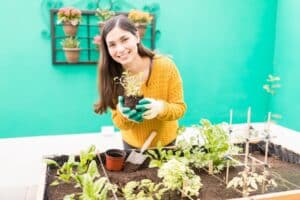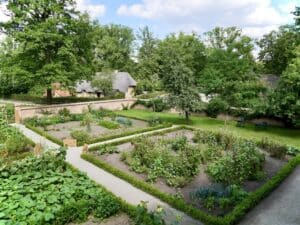Prepare your Garden for Spring – 4 Essential Tips!

It’s finally Spring! As professional gardeners, we spend a lot of our time working outside. We reckon that the mild, sunny days of Spring are a huge relief after a cold Melbourne winter!
Spring is also the best time of year for your plants. Weather conditions are just right for healthy new growth, and the natural cycle of pollination is in full swing. Whether you’re sowing some new seeds or transplanting a bare root plant into your soil, it’s the perfect time to get out the tools and start gardening.
Here’s everything you should be doing to prepare your garden for Spring this year:
1. Tidy up and remove any weeds
Before you do anything else, take some time to assess the situation in your garden. Most Winters can get pretty wet and muddy here in Australia. Plants and weeds alike tend to grow quickly with all of the rain, and it’s not easy to keep up with maintenance when the temperature and conditions outside are miserable.
So when that Spring sun comes around, clear out everything in your soil that you don’t want. This includes roots, weeds, fungi, dead leaves and plants that didn’t survive the winter. It’s good to start again with a clean slate, to help give any new plants you’re growing the best chance of success.
If you have a home composter or a favourite DIY mulch recipe, you might want to keep aside some of that useful organic matter to be used as mulch or compost. This includes grass clippings or those dead leaves, but be careful of any unwanted weed roots or seeds. Anything you don’t want to recycle can go straight into the green waste bin.
If you’re up for it, you can keep this gardening momentum going and go ‘all out’ with your Spring cleaning. Some gardeners like to take this time to sharpen their tools, repair fences and structures, clear out the gardening shed, mow the lawns and generally tidy up the place.
But after all of that weeding out in the sun, you may find you just want to put your feet up in the shade with an ice-cold drink instead! We know what we’ll be doing.
2. Prune back shrubs and trees
It’s also a good idea to prune plants that have grown a little wild over the winter, especially citrus trees and other edible plants that may start to ‘run’ instead of producing delicious food. This will give your plants the best conditions to thrive as they enter their growth period.
Pruning helps you grow your plant as desired and creates more efficient growth paths for your plant. Plant growth has a lot to do with hormone movement and nutrient allocation, and pruning can help you to control these variables. Cut back low branches or anything that looks spindly, tangled or unhappy. Branches with dead or browning leaves may also benefit from a prune.
If you’re feeling a little nervous, it’s good to remember that one wrong cut is probably not going to kill your plant! However, pruning too often or pruning the wrong way will do damage over time, so always research your plant to see exactly how it should be pruned.
With flowering plants, it’s important not to cut or damage buds as that could prevent further blooming. Some other plants are very sensitive to pruning or have certain important areas that should never be pruned, like the tips of palm trees.
3. Test your soil and prepare it for planting
If you’re anything like us, you’re probably starting to think about all of the strange and wonderful things you’re about to plant in your garden. But it’s a good idea to figure out exactly what kind of soil you’re working with first, to ensure you get the best results.
You should always test your soil before you plant something, but how comprehensively you decide to test it is up to you. At the very least, you should pick up some soil from your garden bed and crumble it between your fingers. This way you can see how loose or compacted your soil is, and get an idea of how well it’s going to drain.
If you’re planning on planting a lot of new plants, it might be a good idea to do some more comprehensive testing. You can purchase pH Testing Kits (as many plants prefer different acidity levels) or more detailed Soil Testing Kits at any of our Diaco’s Garden Centers. A soil test can identify nutrient levels, fertility, chemical makeup and more.
Nurturing a plant is a bit like a long-term investment – your attachment to it will grow the longer it continues to thrive. To minimise the chances of experiencing any disappointments, it’s always a good idea to know about the environment you’re working with right from the beginning.
4. Add Fertiliser, Compost and/or Mulch to Replenish Soil.
So you’ve tested your soil, and turns out it needs a little bit of TLC before you actually plant anything. Don’t be alarmed though! It’s very common and easily fixed with the right additives.
After a big winter, it’s pretty normal for soil to be a bit depleted. Nutrients can be flooded out by persistent rain, and regular avenues for drainage may have become clogged over time, leading to damp and soggy soil. Depending on the kind of soil reparation you’re looking for, the best way to improve it is usually to use some combination of fertiliser, compost or mulch.
These are all different methods of adding organic matter and nutrients into your soil for your plants to enjoy. For many plants, an annual dose of fertiliser at the beginning of Spring is all the help they need. It’s best to enrich your soil at least a week before planting, to give nutrients enough time to be absorbed.
Using mulch, fertiliser and compost all at once may actually be overkill for some plants, but you should really be using at least one or two of these methods semi-regularly for the best results.
Fertiliser
Fertiliser is any mix of natural or chemical substances that encourage plant growth. It’s considered ‘plant food’ and helps give them the nutrients they need. Poor soil may not have enough of these nutrients, so fertiliser is essential in these cases.
Fertiliser comes in many forms, but most fertilisers work by combining nutrients like nitrogen, phosphorous and potassium. Bags of fertiliser are best for repairing or enriching large areas of soil, whilst liquid fertiliser or plant food is better for adding regularly to your plants during the fruiting season.
Compost
Compost is a mix of decomposing organic material that adds lots of nutrients to your soil as it continues to decompose. Worms and microorganisms eat compost and convert it into highly fertile soil. It can also help a lot with breaking up your soil and increasing drainage.
Mixing compost through your soil is one of the best ways to enrich and repair it. Compost can be created DIY with a bit of time and effort, but it’s also conveniently available in pre-formulated bags. You can find high-quality compost in our online plant store.
Mulch
Mulch is any organic (or inorganic) material that is placed on top of your soil. This is one of the main things that differentiate it from compost or fertiliser. Common mulch materials include Pea Straw, Sugarcane and Pine Bark, while inorganic mulches are usually pebbles or rocks. We’ve also put together our own Diacos Organic Mulch mix that gives great results.
Mulch will also benefit soil health as it decomposes, but it is perhaps most useful for water retention. Laying mulch around your plants and above your soil will delay evaporation and help your plant retain moisture for longer, leading to less frequent watering from you!
Start to plan ahead for the future:
Finally, it’s a good idea to write things down and prepare yourself for the year to come. Staying on top of your gardening in this way will make things much easier as time goes by, allowing you to pursue all of your ambitious and exciting garden ideas.
How organised you like to be is up to you, but there are two things that we always recommend:
- Make a calendar! We think this is one of the most useful things you can do! Keep track of the times of year you planted and when things are in bloom. Understanding the cycles of your garden is important, and recording them takes out the guesswork.
- Stock Up on Supplies. Now is a good time to use that gardening momentum. Use large plastic containers to stock up on rainwater for summer, and consider building up a stash of fertiliser, compost, mulch and weedkiller. It’s always good to prepare!
Combine this with all of the steps above, and you’re as ready as you’ll ever be for a wonderful spring of gardening in the sun. Your plants are sure to love the fertile, green environment you have created for them. Check out some of our other Spring guides below:
- Top 7 Vegetables to Plant in Spring
- Top 10 Plants to Plant this Season (Spring)
- Top 5 Tips to Prepare Your Lawn For Spring
Happy growing and good luck!
Don’t be afraid to ask our friendly team if you have any specific questions about preparing your garden beds for Spring. You can get your gardening journey started today at one of our Diaco’s Garden Centres or our Online Garden Store.
-
 13, Jun, 2025
13, Jun, 2025How to Start a Garden Design Project: Step-by-Step Planning Guide for Beginners
At Diaco’s, we know that creating a beautiful garden starts... -
 27, May, 2025
27, May, 2025Smart Garden Layout Ideas: How to Maximise Your Outdoor Space
At Diaco’s, we believe every garden has potential. Whether you’ve... -
 9, May, 2025
9, May, 20257 Garden Design Principles to Transform Your Outdoor Space
At Diaco’s, we know that creating a garden isn’t just...


